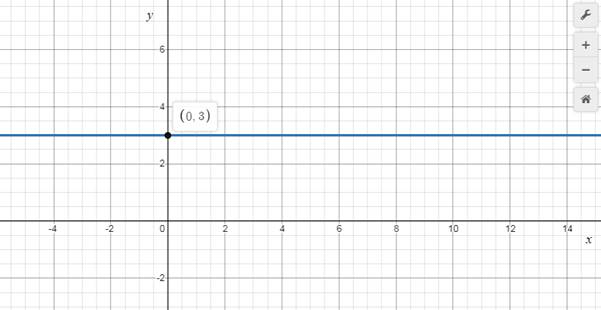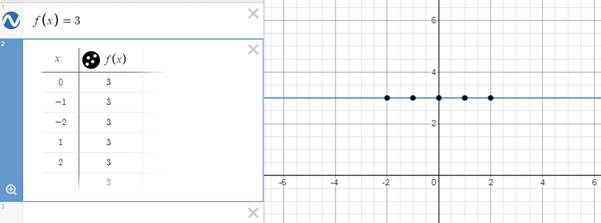
Concept explainers
(a)
To sketch: the graph of the given function.
(a)
Explanation of Solution
Given information:
The function
Graph:
The given function is sketched as shown below.

Interpretation
From the graph, it can be seen that the given function is a constant for all real values of x .
(b)
To find: the nature of the function from the graph and using a table of values of the function.
(b)
Answer to Problem 31E
The given function is constant.
Explanation of Solution
Given information:
The function
From the graph of the function in previous part, it can be seen that, for all values of x from -8 to 8 , the value of f (x ) remains constant at 3. Thus, the given function is a constant function over the interval (-8,8).
Now, the values of the given function for different values of x are shown in the below table.

From the table, it can be verified that, for all the values of x considered, the function remains constant at value 3. Thus,
Chapter 1 Solutions
PRECALCULUS W/LIMITS:GRAPH.APPROACH(HS)
- The evolution of a population of Hippos, R(t), in hundreds, time in years, in an African National Park is given by the equation, dR dt (a) Solve the system exactly for R(t). = R(7 – R); R(0) = 3 2 (b) What happens as the time t → ∞o, i.e. what is the population a long time in the future? (c) Write an Euler scheme and compute until the population levels off (using Excel, Matlab, Octave, LibreCalc or similar). Do it twice, once with At = 0.1 and once with At = 0.05. (d) Plot all of your solutions on the same set of axes and comment.arrow_forwardfind For triangle ABC, with vertices A = (3,-1,2), B = (-5,4,-4) and C = (6, −1, −1), (a) the length of side AB, (b) the equation of the line that passes through A and B, (c) the angle at vertex B, (d) a vector perpendicular to the plane containing the triangle ABC, (e) the area of the triangle ABC. (f) the equation of a plane passing through A, B and C.arrow_forwardShowing all working, use the row reduction method to find the inverse of B, given by 5 -1 B = -3 1 3 1 -3 2arrow_forward
- Consider the matrix A, given by +63) A = 1 -3 4 -3 4 5 -105 (a) Find the determinant of the matrix, A. (b) Find all possible solutions, x, to the system Ax = b, where b is the column vector, (1,2, −4).arrow_forwardIf a (1,4,2) and b = (−1, −5,3), find |a|, a + b, 3a - 2b, a b, a x b and b × a. What is the angle between a and b?arrow_forwardShowing all working, find the eigenvalues and corresponding eigenvectors of -3 (a) (27) 6arrow_forward
- Showing all working and using row operations determine all solutions to the follow- ing system of equations. 2x + 3y-2z = 8, -2x+y+6z= 12, -x+3y-2z = −4.arrow_forward8:38 *** TEMU 8 5G. 61% Score on last try: 0 of 1 pts. See Details for more. > Next question Get a similar question You can retry this question below Give the equation for the function which would have graph shown below. Use f(x) for the output. 54 3 2 1 12-11-10 -8 -7 -6 -5 -4 -3 -2 -3 23456 -4 -5 -6 -2 f(x) = 3 sin ( 7/7 x ) +2 Question Help: ☑Video ☑Message instructor Submit Question ||| <arrow_forward2:21 MM -8 -7 -6 -5 -4 0 5 4 3 2 N -3 -4 +5 +6 5G 100% Identify the function whose graph appears above. f(x) = = tan X 3 ✓ Question Help: ☐ Video ☐ Message instructor Submit Question |||arrow_forward
 Calculus: Early TranscendentalsCalculusISBN:9781285741550Author:James StewartPublisher:Cengage Learning
Calculus: Early TranscendentalsCalculusISBN:9781285741550Author:James StewartPublisher:Cengage Learning Thomas' Calculus (14th Edition)CalculusISBN:9780134438986Author:Joel R. Hass, Christopher E. Heil, Maurice D. WeirPublisher:PEARSON
Thomas' Calculus (14th Edition)CalculusISBN:9780134438986Author:Joel R. Hass, Christopher E. Heil, Maurice D. WeirPublisher:PEARSON Calculus: Early Transcendentals (3rd Edition)CalculusISBN:9780134763644Author:William L. Briggs, Lyle Cochran, Bernard Gillett, Eric SchulzPublisher:PEARSON
Calculus: Early Transcendentals (3rd Edition)CalculusISBN:9780134763644Author:William L. Briggs, Lyle Cochran, Bernard Gillett, Eric SchulzPublisher:PEARSON Calculus: Early TranscendentalsCalculusISBN:9781319050740Author:Jon Rogawski, Colin Adams, Robert FranzosaPublisher:W. H. Freeman
Calculus: Early TranscendentalsCalculusISBN:9781319050740Author:Jon Rogawski, Colin Adams, Robert FranzosaPublisher:W. H. Freeman
 Calculus: Early Transcendental FunctionsCalculusISBN:9781337552516Author:Ron Larson, Bruce H. EdwardsPublisher:Cengage Learning
Calculus: Early Transcendental FunctionsCalculusISBN:9781337552516Author:Ron Larson, Bruce H. EdwardsPublisher:Cengage Learning





